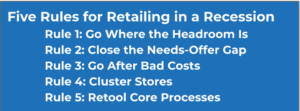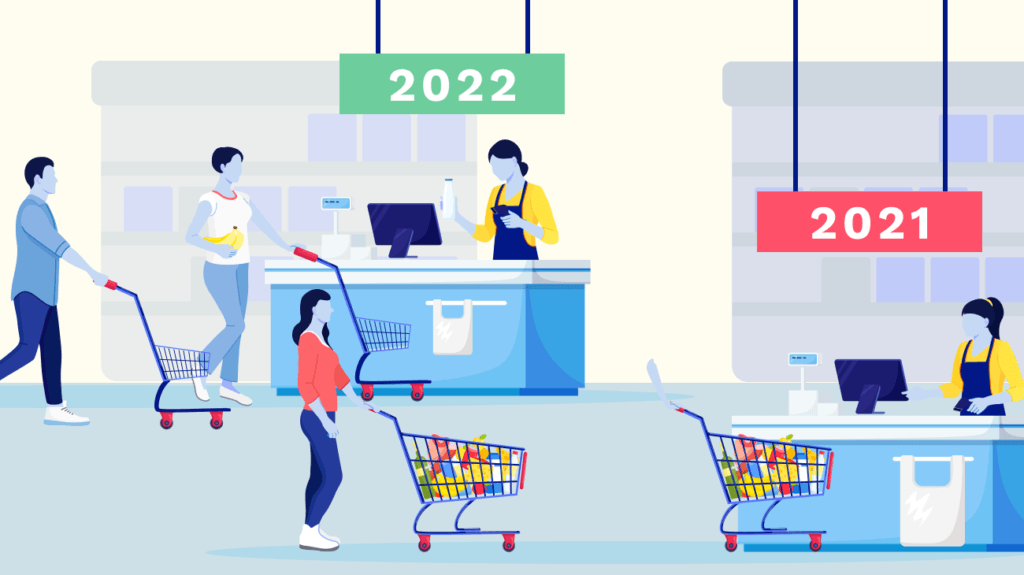The Secrets of Retailers in a Recession
It is no longer “breaking news” to say that the global economy is headed towards some level of recession. The signs are everywhere and retailers are bracing for impact. And while no one wants to find themselves in this situation, in the words of Sun Tzu, “In the midst of chaos, there is also opportunity” (“The Art of War”). Recessions are not new; you can successfully emerge on the other side of them by making good decisions. So what is the secret to success for retailers in a recession?
In an HBR classic titled “Five Rules for Retailing in a Recession” (first published in 2009, in the wake of the last major global recession), the authors proposed a set of guidelines for retailers to focus on when times get tough. While the business logic remains relevant, changes in technology have made it possible to apply these rules with great effect.

For example, Rule No. 1 is about finding “headroom”, defined as the market share you don’t have minus the market share you will never have. Finding headroom in a recession, it is claimed, boils down to identifying those users for whom you represent a small share of wallet. Those users are shopping both in your stores and in others. The logic is simple. Users who are completely loyal are already spending the maximum they can. New users are expensive to pursue, lure in and convert. Therefore, maximizing the potential of under-utilized customers offers the biggest opportunity.
Fortune Favors the Bold
With personalization based on real-world insights, isolating these “switchers” is only the first step. Thanks to insights into their habits, hobbies and preferences, you can devise much more precise campaigns. The goal is to engage sub-segments of these “switchers” with targeted messages and customized offers. This puts retailers in position to “go on the offensive”, as suggested by McKinsey in 2020 in their analysis of retailers and recession (“How Retailers can Build Resilience Ahead of a Recession”). The paper explains that for “resilient retailers” investing to increase market share will generate increases in revenue while others experience drops.
The keys to the success of retailers in a recession rely, according to both papers, on analysis. You need a good grasp of both your customer base and your perceived value proposition. You need to know who your customers are, what they are buying, why they are buying from you and where else do they buy it from. To “Close the Needs-Offer Gap” (Rule No. 2) figuring out what customers are buying elsewhere will help you to adjust your offer so you can be the one offering it to them. As McKinsey suggests, this can be the time to move into new markets.

However, many companies, especially retailers in a recession, are cash-strapped. They can’t afford (or don’t want to spend) the money for consultants like McKinsey to conduct such an analysis. Real-world insights, on the other hand, can generate the input necessary for making such decisions. As the insights are generated on an ongoing basis, they are available to drive segmentation to engage individual users. In addition, they are aggregated into an audience-wide dashboard that teaches retailers more about who their audience is when they are not in the store or the app. Such aggregated insights can guide discussions on good costs vs. bad costs (Rule No. 3) and Store Clustering (Rule No. 4). By indicating, for example, who the discounts should go to and on which product lines, these aggregated insights will help “reshape the value proposition” (McKinsey).
Follow the Insights
That is why real-world insights are the key for retailers to successfully weather a recession. By generating insights about the real-world behavior, preferences and routines of mobile users, without being completely reliant on their transactions and digital clickstream, retailers capture the most important resource of all, knowledge. The knowledge that will help them follow the rules and strengthen their resilience.
Both papers also agree: cost cutting in a recession is often necessary but should never be automatic. Trimming excess budgets is always prudent, but making deep cuts on marketing, customer service and operations are not the practices of resilient retailers. So personalization may well be the smartest investment for retailers in times of economic pressures. Buying personalization, for example with budgets spent on 3rd party ad campaigns, is expensive and the costs are never ending. The smarter option is to build personalization, by implementing a solution that generates insights for you about your customers. This means investing in an infrastructure that, in the near term, will help you successfully survive recession. In the future, this infrastructure will save you a fortune, annually, by reducing your advertising budgets. You are laying the foundations for what will become a strategic asset.
In rough times you not only need to cut bad costs, you need to make smart investments. Invest in being able to improve your understanding of your customers and you’ll reap the rewards in good times and in bad.
